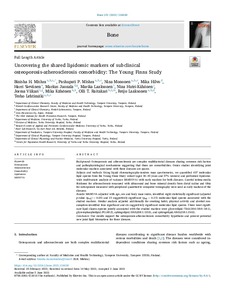Hae
Aineistot 11-20 / 97
Changes in BMI and physical activity from youth to adulthood distinguish normal-weight, metabolically obese adults from those who remain healthy
<p>Highlights</p><p>Adults with MONW have a lower BMI during youth until young adulthood, but higher BMI after this than adults with metabolically healthy normal weight. Adults with MONW have a greater decrease in physical ...
Sex Differences in Cardiovascular Outcomes of Older Adults After Myocardial Infarction
<p>Background Evidence on the impact of sex on prognoses after myocardial infarction (MI) among older adults is limited. We evaluated sex differences in long-term cardiovascular outcomes after MI in older adults. Methods and Results All patients with MI ≥70 years admitted to 20 Finnish hospitals during a 10-year period and discharged alive were studied retrospectively using a combination of national registries (n=31 578, 51% men, mean age 79). The primary outcome was combined major adverse cardiovascular event within 10-year follow-up. Sex differences in baseline features were equalized using inverse probability weighting adjustment. Women were older, with different comorbidity profiles and rarer ST-segment-elevation MI and revascularization, compared with men. Adenosine diphosphate inhibitors, anticoagulation, statins, and high-dose statins were more frequently used by men, and renin-angiotensin-aldosterone inhibitors and beta blockers by women. After balancing these differences by inverse probability weighting, the cumulative 10-year incidence of major adverse cardiovascular events was 67.7% in men, 62.0% in women (hazard ratio [HR], 1.17; CI, 1.13-1.21; P<0.0001). New MI (37.0% in men, 33.1% in women; HR, 1.16; P<0.0001), ischemic stroke (21.1% versus 19.5%; HR, 1.10; P=0.004), and cardiovascular death (56.0% versus 51.1%; HR, 1.18; P<0.0001) were more frequent in men during long-term follow-up after MI. Sex differences in major adverse cardiovascular events were similar in subgroups of revascularized and non-revascularized patients, and in patients 70 to 79 and ≥80 years. Conclusions Older men had higher long-term risk of major adverse cardiovascular events after MI, compared with older women with similar baseline features and evidence-based medications. Our results highlight the importance of accounting for confounding factors when studying sex differences in cardiovascular outcomes.</p>...
Association between Life Stressors and Arterial Stiffness: The Finnish Retirement and Aging Study
<p>Objective: Besides traditional risk factors, other factors such as life stressors are linked with incident cardiovascular disease. However, the underlying mechanisms for this association remain mostly unknown. We studied ...
Weight gain in infancy and markers of cardiometabolic health in young adulthood
Aim We studied whether repeatedly measured weight gain from birth up to age 2 years associated with cardiometabolic health in young adulthood. Methods Using the data collected in the longitudinal Special Turku Coronary ...
Attainment of Targets of the 20-Year Infancy-Onset Dietary Intervention and Blood Pressure Across Childhood and Young Adulthood The Special Turku Coronary Risk Factor Intervention Project (STRIP)
We examined whether success in achieving the key targets of an infancy-onset 20-year dietary intervention was associated with blood pressure (BP) from infancy to young adulthood. In the prospective randomized STRIP (Special ...
Uncovering the shared lipidomic markers of subclinical osteoporosis-atherosclerosis comorbidity: The Young Finns Study
<p>Background: Osteoporosis and atherosclerosis are complex multifactorial diseases sharing common risk factors and pathophysiological mechanisms suggesting that these are comorbidities. Omics studies identifying joint ...
Body-mass index trajectories from childhood to mid-adulthood and their sociodemographic predictors: Evidence from the International Childhood Cardiovascular Cohort (i3C) Consortium
<p>Background<br>Understanding lifecourse trajectories of body-mass index (BMI) is important for identifying groups at high risk of poor health and potential target points for intervention. This study aimed to describe BMI ...
Assessment of plasma ceramides as predictor for subclinical atherosclerosis
<p>Background and aims</p><p>Ceramides have been identified as novel biomarkers for cardiovascular disease (CVD) related events and mortality but their role in etiology of subclinical atherosclerosis is unknown. We aimed ...
Lower grip strength in youth with obesity identifies those with increased cardiometabolic risk
<p>Background: We examined whether grip strength differentiates youth with obesity with increased cardiometabolic risk.</p><p>Methods: The sample comprised 43 youth with severe obesity (mean age 14.8, standard deviation ...
Carotid artery longitudinal wall motion alterations associated with metabolic syndrome and insulin resistance
Background and aims: Our objective was to study relationships between the new biomarker of vascular health, carotid artery longitudinal wall motion (CALM) and metabolic syndrome (MetS).<div><br></div><div>Methods: Carotid ...









